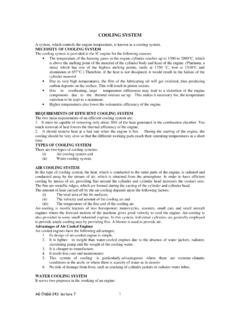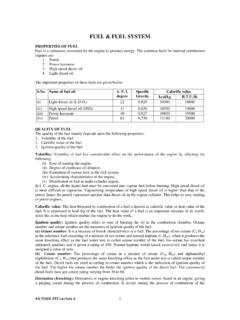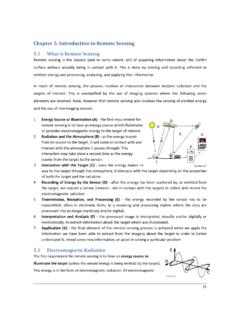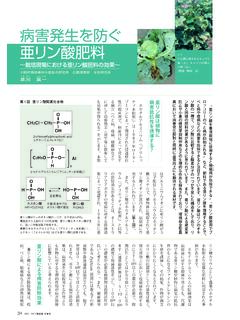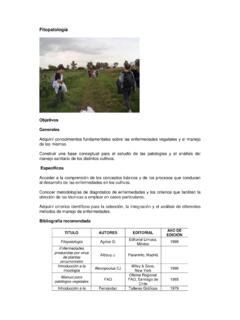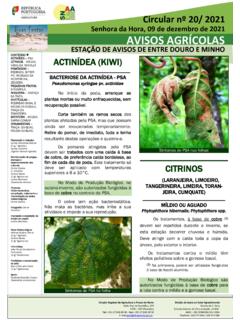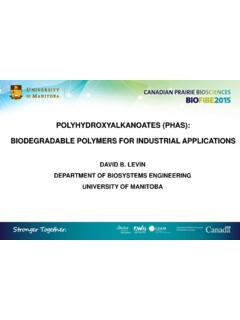Transcription of PRINCIPLES OF PLANT PATHOLOGY
1 PRINCIPLES OF PLANT PATHOLOGY Pl. Path. 111 (Cr. Hrs. 3+1) Sharma Department of PLANT PATHOLOGY , CSK HPKV, Palampur ( ) An introduction to PLANT PATHOLOGY What is PLANT PATHOLOGY ? Objectives of PLANT PATHOLOGY Disease & Disorder PLANT Pathogens Classification of diseases Terminology What is PLANT PATHOLOGY ? Phytopathology (Phyton : PLANT ) Greek - Pathos (suffering) + Logos (study) = The study of the suffering PLANT PLANT PATHOLOGY is that branch of agricultural, botanical or biological sciences which deals with the study of: cause of the disease Resulting losses and Control of PLANT diseases Objectives of PLANT PATHOLOGY of origin, causes or reasons. Study of living, non-living and other causes of disease or disorder in plants- Etiology: of mechanism of disease development processes of infection and colonization of the host by the pathogen.
2 This phase involves complex host-pathogen interactions- Pathogenesis the interaction between the causal agent and the diseased plants in relation to environmental conditions. Generally at the population level- Epidemiology of management systems of the diseases land reduction of losses caused by them- Control/ Management. What is health? The ability to carry out normal physiological functions at a acceptable level consistent to genetic potential. Normal physiological functions include: Normal call division, differentiation, and development, Absorption of water and minerals from the soil and translocation; Photosynthesis and translocation of photosynthates; Utilization and storage of photosynthates; Metabolism of metabolites and synthates; Reproduction; Storage of reserves for overwintering or reproduction. PLANT PATHOLOGY is both science (of Learning and understanding the nature of disease ) and Art (of diagnosing and controlling the disease) PLANT is healthy, or normal, when it can carry out its physiological functions to the best of its genetic potential.
3 Any deviation- Disease The kinds of cells and tissues that become affected determine the type of physiological function that will be For example, infection of roots may cause roots to rot and make them unable to absorb water and nutrients from the soil; infection of xylem vessels, interferes with the translocation of water and minerals to the crown of the PLANT ; infection of the foliage, (leaf spots, blights, rusts, mildews, mosaics etc.), interferes with photosynthesis The Concept of Disease in Plants What is a Disease Stakman & Harrar (1957) defined disease as physiological disorder or structural abnormality that is deleterious to the PLANT or its part or product, that reduces the economic value of the PLANT , wilt, potato blight, Loose smut of wheat, karnal bunt of wheat Disease Disease the process in which a pathogen interferes with one or more essential PLANT cell functions Marshall Ward (1901): disease represents a condition in which functions of the PLANT are not properly discharged.
4 Disease is a harmful deviation from normal functioning of physiological processes. (British Mycological Society, 1950) Horsfall & Diamond (1957): Disease can be defined as a physiological disorder or structural abnormality that is deleterious or harmful toe the PLANT or its part or product that reduces its economic value. Disease can be defined as the result of interaction between host, pathogen and environment How Pathogens affect Plants There are many ways in which PLANT disease pathogens can affect plants By utilizing host cell contents By killing host or by interfering with its metabolic processes through their enzymes, toxins etc. By weakening the host due t continuous loss of the nutrients. By interfering with the translocation of the food, minerals land water. They can suppress the chlorophyll content. They can reduce the leaf area.
5 They can curb the movement of solutes and water through the stems. They sometimes reduce the water-absorbing capacity of the roots. They suppress the translocation of photosynthates away from the leaves. They sometimes promote wasteful use of the products of photosynthesis as in the formation of galls. Disease Triangle Disease Host Pathogen Environment Conditions for disease Host should be susceptible Pathogen should be virulent Environment should be favourable for the disease TIME Environment Host Pathogen Human Activity Time Disease Tetra-hedron Classification of PLANT diseases Based on type of symptoms Blights Rusts Smuts Rots wilts Based on type of crop Cereal diseases Vegetable diseases Fruit Based on type of organ affected Fruit diseases Root diseases Based on cause: Infectious diseases Non-infectious diseases PLANT Disease Agents Living organisms - including fungi, bacteria, viruses and nematodes Nonliving agents - including unbalanced soil fertility, toxic chemicals, air pollution, frost, drought, sunburn, wind and hail Infectious PLANT Disease Causes Fungi Bacteria Viruses Viroids Virusoids Protozoa Nematodes Algae Parasitic Plants Non-infectious diseases (due to abiotic factors Environmental stress/ excess Temperature high or low Moisture excess- rotting or Stress-wilt/drying Air Light etiolation Nutritional imbalance Excess Deficiency N deficiency, Zn deficiency Disorder: Abnormal physiological change due to non-parasitic agent or is a non-parasitic physiological malfunctioning due to either excess or deficiency in environmental factors or nutrients.)
6 Physiological wilt, sun scald, Nutrient deficiency) Disorder Iron Deficiency Scope & Importance of PLANT diseases Scopes & Importance of PLANT Diseases PLANT PATHOLOGY deals with different aspects of PLANT diseases and has wide scope than human PATHOLOGY which only deal with only one aspect In recent years PLANT pathologists have begun to specialize in particular aspect. The field in which notable advances have been made are: Interaction between host and pathogen at chemical, molecular and genetic level PLANT virology, chemistry of fungitoxicity Disease forecasting On practical aspects much advances have been made in PLANT protection chemicals; breeding for disease resistance Increased population emphasizes the application of all possible means to meet the food requirements Expansion of crop area Improved methods of cultivation Increased use of fertilizers Improved varieties Increased irrigation Crop protection Importance of PLANT Diseases Late blight of potato-1841-51 (Irish famine) Coffee rust 1867-1870 (Srilanka) Downy mildew of grapes (1880s) (France) Bengal Famine 1942 (India) Bacterial Blight of Rice 1963 (Bihar) Southern corn leaf blight -1970 (USA) Estimated annual losses worldwide Diseases Insects Weeds Total av.
7 Looses Losses are more in developing world and less in develop world Losses caused by PLANT Diseases Terminology Parasite Pathogen Pathogenicity Pathogenesis Symptom Sign Syndrome Hypersensitivity Host Alternate host Collateral host Resistance Susceptibility Tolerance Parasite An organism that lives on or in another organism and obtains food from the second organism Pathogenicity- is the ability of a pathogen to cause the disease by interfering with one or more of the essential PLANT cell functions. What is Pathogen? Any entity that can cause disease in a host eg. Fungus, Bacteria, virus, Phytoplasma, Viroids, RLO s, Parasitic Plants, Nematodes symptom and Sign Symptom are the expression of the disease caused by the manifestation of the physiological reaction of the PLANT due to harmful activity of the pathogen Sign - physical evidence of the presence of disease agent ( , mold or fungal spores, bacterial ooze) Syndrome Defined as sequential appearance of disease symptoms on a PLANT during the development of the disease or sum total of symptoms exhibited by a disease Fleck or necrotic spot Blight Fungal growth Death of of organ or PLANT Facultative Parasite: usually grows and completes life cycle on dead material, but can do so on living tissue.
8 Sclerotinia Facultative Saprophyte: usually grows and completes life cycle on living tissue, but can do so on dead material. Phytophthora infestans Necrotrophs kill their host before feeding on the cells or the cell s contents and live on dead tissue. Rhizoctonia Biotrophs do not kill PLANT cells. They penetrate the cell wall and establish a continuous relationship or move from cell to cell. Rusts, powdery mildew, Host: any organism that harbour another organism is called host Alternate host: is the host that help in the completion of the life cycle of the pathogen and its survival, belong to diff. family Collateral host: host of the same family and help in the survival of the pathogen Infection: Establishment of organic relationship between host and pathogen Pathogenesis: Chain of events that takes place during the development of disease (inoculation to survival of the pathogen) Susceptibility: Inability of the host to resist the attack of the pathogen Tolerance: is a type of defence that minimises crop losses with out restricting the disease development.
9 Resistance: Ability of the host to resist the attack of the pathogen Horizontal resistance Vertical resistance Hypersensitivity: is the quick death of the host tissue in the vicinity of the pathogen Disease escape: it is ability of the susceptible host to avoid the damaging disease stress unfavorable environment/ growth habit Virulence: It is defined as the degree of pathogenecity of a particular isolate or race of the pathogen . Aggressiveness: it is the capacity of the pathogen to invade and colonize the host and to reproduce on or in it. Predisposition: it is the set of conditions that makes the PLANT vulnerable to the attack of the pathogen Terms describing microbial habitats related to plants: Epiphytic = organisms growing on the surface of photosynthetic organisms Endophyitc= organisms growing inside the host Phylloplane = leaf surface Phyllosphere = area surrounding the leaf and impacted by it Rhizoplane = root surface Rhizosphere = area surrounding the root and impacted by it PLANT PATHOLOGY - Today & Future Molecular PLANT PATHOLOGY Discovery of WM Stanley in 1935 about proteinaceous nature of the TMV can be considered as beginning of the molecular PLANT \ PATHOLOGY , though two years later, Bawden and Pierie showed the presence of small amount of RNA with it.
10 Gierrer & Schramm in 1956 RNA as infectious not protein and also replicate. 1941, Beadle & Tatum showed that one gene code for one enzyme 1942, HH Flor- Gene for Gene hypothesis 1953, Watson & Crick- DNA in a double helix form a major discovery In mid 1960s , TMV studies helped in elucidation of the gentic code showing that specific base triplet of DNA (and RNA) code for a certain amino acid. In 1970s, study on Agrobacterium tumefaciens T-DNA contain Ti-Plasmid having many genes, of which two code for growth hormones leading to tumour formation. Later these plasmids were used as vector to transfer genes to other organisms including plants. Later viruses were also used as vectors in genetic engineering. In 1984, Albersheim et al., identified a molecule later called elicitor, in the cell wall of the Phytophthora megasperma that act as elicitor of the defence response in its soybean host.
